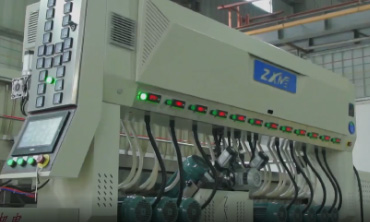In 2024, the price of glass futures and spot prices will fall simultaneously, but the rhythm of the two will be different. Futures prices fell first and then rose in the first half of the year, and entered a three-month downward cycle after June, once approaching 1,000 yuan/ton in mid-September, and then rebounded in stages. Spot prices have been in a downward trend for a long time, bottoming out at the end of September. As of late December, the annual decline in the market price of 5mm large slabs in Shahe and Hubei was about 27.14% and 36.55% respectively.
The production capacity of glass may have bottomed out, and the change range in 2025 is limited
From January to November 2024, the average daily melting volume of float glass in production was 169,600 tons, a slight increase of 1.41% year-on-year; From January to November, the output of float glass was 50.2454 million tons, a year-on-year increase of 3.90%. Due to the shrinking profits of the glass industry after March, the production line began to stop production and cold repair, and the production capacity fell rapidly, and the glass production capacity fell to the lowest level in five years at the end of September. As the glass supply in the first half of the year was at a historical high, pulling up the average supply for the whole year, even if the decline in glass production accelerated in the second half of the year, it did not change the trend of increasing glass production throughout the year. It is estimated that the glass output in 2024 will be 54.6689 million tons, an increase of 3.07%.
Since the end of September this year, the profits of the glass industry have been restored, and the frequency of cold repair of production lines may slow down significantly. Although the industry will still be in the alternating stage of cold repair and resumption of production line in 2025, the glass supply level may have bottomed out. According to the existing data, the average daily melting volume of glass in 2025 will decrease by about 6% compared with this year, falling to about 159,400 tons. As the average daily melting of glass this year was pulled up by the level of the first half of the year, even if the decline in 2025 is obvious, the annual average of daily melting volume next year will still rise slightly compared with the level at the end of this year, corresponding to an increase of about 0.19% in glass production. In 2025, glass production may increase slightly to 54.7728 million tons.
Real estate demand continued to decline, and consumption of second-hand housing and home improvement picked up
In 2024, the terminal demand for glass will continue to be sluggish, with the sales area of domestic commercial housing falling by 14.3% year-on-year from January to November, and the area of new housing starts, constructions and completions falling by 23%, 12.70% and 26.20% year-on-year respectively. Constrained by the weakness of the terminal, glass consumption also declined. From January to October 2024, the domestic float glass consumption was 44.261 million tons, a year-on-year decrease of 0.85%. From November to December, although there is support from the end of the year to rush work, there is also an expectation of early shutdown and holiday in the downstream. Therefore, the annual glass consumption in 2024 will be about 53.054 million tons, a year-on-year decrease of about 2.61%.
In 2020, the area of new housing starts in China entered a negative growth stage, and the decline continued to expand in the second half of 2022, and although the decline narrowed from 2023 to 2024, the cumulative year-on-year decline exceeded 20%. According to the calculation of the transmission cycle of 18 to 24 months from new construction to completion, the area of real estate completions will still be in a negative growth state from 2025 to 2026, and the consumption of glass will continue to decline.
The meeting of the Political Bureau of the CPC Central Committee held on December 9, 2024 proposed that "in 2025, more active and promising macro policies will be implemented to expand domestic demand", "more active fiscal policies and moderately loose monetary policies will be implemented, the policy toolbox will be enriched and improved, unconventional counter-cyclical adjustment will be strengthened, and a good policy 'combination punch'" will be played", "the property market and stock market will be stabilized", "consumption will be vigorously boosted, investment efficiency will be improved, and domestic demand will be expanded in all directions". Under the stimulus of a series of policies, the real estate industry has the objective conditions to stop falling and stabilize, but it will take a long time to implement it into the industrial chain.
On the good side, the demand for second-hand housing and home decoration and subsidy policies such as "trade-in" are expected to drive a small number of home appliances to replace demand, promote the recovery of consumption of automobiles, electronic products and home appliances, and hedge the decline in some real estate consumption.
Under the optimistic scenario, glass consumption will decline by about 3% in 2025, and under the pessimistic scenario, glass consumption will decline by 6% next year, corresponding to specific consumption of 51.46 million tons and 49.87 million tons respectively.
The export of raw film and deep processing determines the inventory level
In 2024, the inventory of the glass industry will fluctuate at a medium and high level as a whole, and the enthusiasm for picking up goods in the middle and lower reaches will increase at the end of September, and the inventory of glass enterprises will be significantly reduced. As of mid-December, the inventory of glass companies was 47.625 million heavy containers, an increase of 48.54% from the end of 2023.
The decline in demand in 2025 is enough to cause glass to enter a high inventory state again, but it ignores the impact of imports and exports of glass and deep-processed products. In the past two years, the net export volume of raw glass has remained at 460,000~470,000 tons, and the absolute level is not high. If the import and export quantity of deep-processed products is taken into account, it will greatly alleviate the pressure on domestic glass supply.
In 2024, the net export volume of glass and deep-processed products is expected to be 3.273 million tons, a year-on-year decrease of 3.26%. There are many uncertainties in exports in 2025. On the one hand, the strong US dollar will improve the competitiveness of China's glass and processed products; On the other hand, trade frictions will cause certain disturbances to China's exports. Therefore, under the pessimistic scenario, the net export volume of China's glass and deep-processed products is expected to be 3.074 million tons in 2025, a year-on-year decrease of 6%; In an optimistic scenario, net exports may reach 3.26 million tons, down only slightly from this year.
In summary, exports may become one of the key factors determining the supply and demand pattern of glass in 2025. If the export of glass and deep-processed products can offset the decline in domestic demand, the annual supply and demand of glass are expected to reach a basic balance; Once exports are obviously restricted, the gap between glass supply and demand in 2025 may be around 1.83 million tons, which will be further reflected in the inventory pressure.







 +86 15015515518
+86 15015515518





